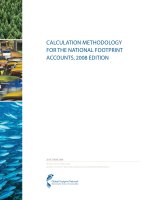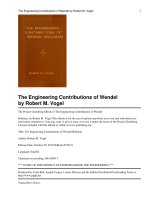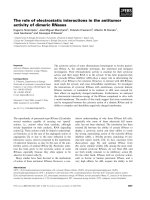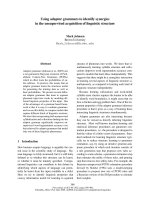Research Report Series No. 18: The water footprint of cotton consumption docx
Bạn đang xem bản rút gọn của tài liệu. Xem và tải ngay bản đầy đủ của tài liệu tại đây (1.59 MB, 44 trang )
The water footprint of
cotton consumption
Value of Water
A.K. Chapagain
A.Y. Hoekstra
H.H.G. Savenije
R. Gautam
September 2005
Research Report Series No. 18
The water footprint of
cotton consumption
A.K. Chapagain
A.Y. Hoekstra
H.H.G. Savenije
R. Gautam
September 2005
Value of Water Research Report Series No. 18
UNESCO-IHE Delft
P.O. Box 3015
2601 DA Delft
The Netherlands
Contact author:
Arjen Hoekstra
E-mail
Value of Water Research Report Series
(Downloadable from )
1. Exploring methods to assess the value of water: A case study on the Zambezi basin.
A.K. Chapagain
−
February 2000
2. Water value flows: A case study on the Zambezi basin.
A.Y. Hoekstra, H.H.G. Savenije and A.K. Chapagain
−
March 2000
3. The water value-flow concept.
I.M. Seyam and A.Y. Hoekstra
−
December 2000
4. The value of irrigation water in Nyanyadzi smallholder irrigation scheme, Zimbabwe.
G.T. Pazvakawambwa and P. van der Zaag – January 2001
5. The economic valuation of water: Principles and methods
J.I. Agudelo – August 2001
6. The economic valuation of water for agriculture: A simple method applied to the eight Zambezi basin countries
J.I. Agudelo and A.Y. Hoekstra – August 2001
7. The value of freshwater wetlands in the Zambezi basin
I.M. Seyam, A.Y. Hoekstra, G.S. Ngabirano and H.H.G. Savenije – August 2001
8. ‘Demand management’ and ‘Water as an economic good’: Paradigms with pitfalls
H.H.G. Savenije and P. van der Zaag – October 2001
9. Why water is not an ordinary economic good
H.H.G. Savenije – October 2001
10. Calculation methods to assess the value of upstream water flows and storage as a function of downstream benefits
I.M. Seyam, A.Y. Hoekstra and H.H.G. Savenije – October 2001
11. Virtual water trade: A quantification of virtual water flows between nations in relation to international crop trade
A.Y. Hoekstra and P.Q. Hung – September 2002
12. Virtual water trade: Proceedings of the international expert meeting on virtual water trade
A.Y. Hoekstra (ed.) – February 2003
13. Virtual water flows between nations in relation to trade in livestock and livestock products
A.K. Chapagain and A.Y. Hoekstra – July 2003
14. The water needed to have the Dutch drink coffee
A.K. Chapagain and A.Y. Hoekstra – August 2003
15. The water needed to have the Dutch drink tea
A.K. Chapagain and A.Y. Hoekstra – August 2003
16. Water footprints of nations
Volume 1: Main Report, Volume 2: Appendices
A.K. Chapagain and A.Y. Hoekstra – November 2004
17. Saving water through global trade
A.K. Chapagain, A.Y. Hoekstra and H.H.G. Savenije – September 2005
18. The water footprint of cotton consumption
A.K. Chapagain, A.Y. Hoekstra, H.H.G. Savenije and R. Gautam – September 2005
Contents
Summary 7
1. Introduction 9
2. Green, blue and dilution water 11
3. Virtual water 13
3.1. General method 13
3.2. The virtual water content of seed cotton 13
3.3. The virtual water content of cotton products 16
4. Impact on the water quality in the cotton producing countries 19
4.1. Impact due to use of fertilisers in crop production 19
4.2. Impact due to use of chemicals in the processing stage 20
5. International virtual water flows 23
6. Water footprints related to consumption of cotton products 25
7. Conclusion 31
References 33
Summary
The consumption of a cotton product is connected to a chain of impacts on the water resources in the countries
where cotton is grown and processed. The aim of this report is to assess the ‘water footprint’ of worldwide
cotton consumption, identifying both the location and the character of the impacts. The study distinguishes
between three types of impact: evaporation of infiltrated rainwater for cotton growth (green water use),
withdrawal of ground- or surface water for irrigation or processing (blue water use) and water pollution during
growth or processing. The latter impact is quantified in terms of the dilution volume necessary to assimilate the
pollution. For the period 1997-2001 the study shows that the worldwide consumption of cotton products requires
256 Gm
3
of water per year, out of which about 42% is blue water, 39% green water and 19% dilution water.
Impacts are typically cross-border. About 84% of the water footprint of cotton consumption in the EU25 region
is located outside Europe, with major impacts particularly in India and Uzbekistan. Given the general lack of
proper water pricing mechanisms or other ways of transmitting production-information, cotton consumers have
little incentive to take responsibility for the impacts on remote water systems.
Water footprint of cotton consumption / 9
1. Introduction
Globally, freshwater resources are becoming scarcer due to an increase in population and subsequent increase in
water appropriation and deterioration of water quality. The impact of consumption of people on the global water
resources can be mapped with the concept of the ‘water footprint’, a concept introduced by Hoekstra and Hung
(2002) and subsequently elaborated by Chapagain and Hoekstra (2004). The water footprint of a nation has been
defined as the total volume of freshwater that is used to produce the goods and services consumed by the
inhabitants of the nation. It deviates from earlier indicators of water use in the fact that the water footprint shows
water demand related to consumption within a nation, while the earlier indicators (e.g. total water withdrawal for
the various sectors of economy) show water demand in relation to production within a nation. The current report
focuses on the assessment and analysis of the water footprints of nations insofar related to the consumption of
cotton products. The period 1997-2001 has been taken as the period of analysis.
The water footprint concept is an analogue of the ecological footprint concept which was introduced in the
1990s (Rees, 1992; Wackernagel and Rees, 1996; Wackernagel et al., 1997; 1999). Whereas the ecological
footprint denotes the area (hectares) needed to sustain a population, the water footprint represents the water
volume (cubic metres per year) required.
Earlier water-footprint studies were limited to the quantification of resource use, i.e. the use of groundwater,
surface water and soil water (Hoekstra and Hung, 2002; Chapagain and Hoekstra, 2003a; 2003b; 2004). The
current study extends the water footprint concept through quantifying the impacts of pollution as well. This has
been done by quantifying the dilution water volumes required to dilute waste flows to such extent that the
quality of the water remains below agreed water quality standards. The rationale for including this water
component in the definition of the water footprint is similar to the rationale for including the land area needed
for uptake of anthropogenic carbon dioxide emissions in the definition of the ecological footprint. Land and
water do not function as resource bases only, but as systems for waste assimilation as well. We realise that the
method to translate the impacts of pollution into water requirements as applied in this study can potentially
invoke a similar debate as is being held about the methods applied to translate the impacts of carbon dioxide
emissions into land requirements (see e.g. Van den Bergh and Verbruggen, 1999; Van Kooten and Bulte, 2000).
We would welcome such a debate, because of the societal need for proper natural resources accounting systems
on the one hand and the difficulties in achieving the required scientific rigour in the accounting procedures on
the other hand. The approach introduced in the current study should be seen as a first step; we will reflect in
terms of possible improvements in the conclusions.
Some of the earlier studies on the impacts of cotton production were limited to the impacts in the industrial stage
only (e.g. Ren, 2000), leaving out the impacts in the agricultural stage. Other cotton impact studies use the
method of life cycle analysis and thus include all stages of production, but these studies are focussed on
methodology rather than the quantification of the impacts (e.g. Proto et al., 2000; Seuring, 2004). Earlier studies
that go in the direction of what we aim at in this report are the background studies for the cotton initiative of the
World Wide Fund for Nature (Soth et al., 1999; De Man, 2001). In our study, however, we aim to synthesize the
10 / Water footprint of cotton consumption a
various impacts of cotton on water in one comprehensive indicator, the water footprint, and we introduce the
spatial dimension by showing how water footprints of some nations particularly press in other parts of the world.
Cotton is the most important natural fibre used in the textile industries worldwide. Today, cotton takes up about
40 percent of textile production, while synthetic fibres take up about 55% (Proto et al., 2000; Soth et al., 1999).
During the period 1997-2001, international trade in cotton products constitutes 2 percent of the global
merchandise trade value.
The impacts of cotton production on the environment are easily visible and have different faces. On the one hand
there are the effects of water depletion, on the other hand the effects on water quality. In many of the major
textile processing areas, downstream riparians can see from the river what was the latest colour applied in the
upstream textile industry. The Aral Sea is the most famous example of the effects of water abstractions for
irrigation. In the period 1960-2000, the Aral Sea in Central Asia lost approximately 60% of its area and 80% of
its volume (Glantz 1998; Hall et al., 2001; Pereira et al., 2002; UNEP, 2002; Loh and Wackernagel, 2004) as a
result of the annual abstractions of water from the Amu Darya and the Syr Darya – the rivers which feed the
Aral Sea – to grow cotton in the desert.
About 53 percent of the global cotton field is irrigated, producing 73 percent of the global cotton production
(Soth et al., 1999). Irrigated cotton is mainly grown in the Mediterranean and other warm climatic regions,
where freshwater is already in short supply. Irrigated cotton is mainly located in dry regions: Egypt, Uzbekistan,
and Pakistan. The province Xinjiang of China is entirely irrigated whereas in Pakistan and the North of India a
major portion of the crop water requirements of cotton are met by supplementary irrigation. As a result, in
Pakistan already 31 percent of all irrigation water is drawn from ground water and in China the extensive
freshwater use has caused falling water tables (Soth et al., 1999). Nearly 70 percent of the world’s cotton crop
production is from China, USA, India, Pakistan and Uzbekistan (USDA, 2004). Most of the cotton productions
rely on a furrow irrigation system. Sprinkler and drip systems are also adopted as an irrigated method in water
scarce regions. However, hardly about 0.7 percent of land in the world is irrigated by this method (Postel,
1992).
Water footprint of cotton consumption / 11
2. Green, blue and dilution water
From field to end product, cotton passes through a number of distinct production stages with different impacts
on water resources. These stages of production are often carried out at different locations and consumption can
take place at yet another place. For instance, Malaysia does not grow cotton, but imports raw cotton from China,
India and Pakistan for processing in the textile industry and exports cotton clothes to the European market. For
that reason the impacts of consumption of a final cotton product can only be found by tracing the origins of the
product. The relation between the production stages and their impacts on the environment is shown in Figure
2.1.
Resource use
Resource use
Crop production at
field level
Processing of cotton
products
Environmental impacts
Green water
Blue water
Fertilizers
Pesticides
Blue water
Chemicals
Return flows
Resources typesProduction stages
Final cotton product
Pollution of resources
Depletion of resources
Pollution of resources
Depletion of resources
Return flows
Figure 2.1. Impact of cotton production on the natural resources.
Although the chain from cotton growth to final product can take several distinct steps, there are two major
stages: the agricultural stage (cotton production at field level) and the industrial stage (processing of seed cotton
into final cotton products). In the first stage, there are three types of impact: evaporation of infiltrated rainwater
for cotton growth, withdrawal of ground- or surface water for irrigation, and water pollution due to the leaching
of fertilisers and pesticides. Following Falkenmark (1995), we use the term ‘green water use’ for the rainwater
used for plant growth and ‘blue water use’ for the use of ground- and surface water for irrigation. Both green and
blue water use can be quantified in terms of volumes used per year. The impact on water quality is quantified
here and made comparable to the impacts of water use by translating the volumes of emitted chemicals into the
dilution volume necessary to assimilate the pollution. In the industrial stage, there are two major impacts on
water: abstraction of process water from surface or groundwater (blue water use), and pollution of water as a
result of the waste flows from the cotton processing industries. The latter is again translated into a certain
volume of dilution water requirement.









